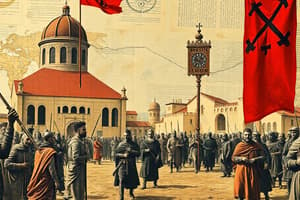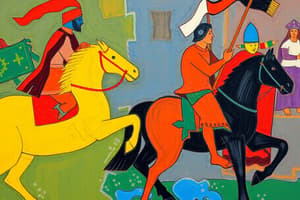Podcast
Questions and Answers
How did Pope Urban II's call for a crusade address both religious and political concerns in Europe?
How did Pope Urban II's call for a crusade address both religious and political concerns in Europe?
He promised remission of sins for participants (religious) and aimed to unite Europe against a common enemy while potentially reconciling with the Eastern Church (political).
Describe the motivations and composition of the 'People's Crusade,' and explain why it failed.
Describe the motivations and composition of the 'People's Crusade,' and explain why it failed.
Motivated by religious fervor, it mainly comprised poor individuals and peasants. It lacked organization, supplies, and military expertise, leading to its quick defeat by the Seljuk Turks.
What were the key terms of the agreement between the Crusaders and Byzantine Emperor Alexios I, and how did the Crusaders abide by them?
What were the key terms of the agreement between the Crusaders and Byzantine Emperor Alexios I, and how did the Crusaders abide by them?
The Crusaders agreed to return conquered Byzantine lands to the Byzantine Empire. While they initially complied, tensions arose, especially after the capture of Antioch, leading to disputes over control.
How did the establishment of the Crusader States create both opportunities and challenges for the Crusaders in the Middle East?
How did the establishment of the Crusader States create both opportunities and challenges for the Crusaders in the Middle East?
What impact did Nur ad-Din's actions have on the context that incited the Second and Third Crusades?
What impact did Nur ad-Din's actions have on the context that incited the Second and Third Crusades?
Explain how the Battle of Hattin contributed to the Third Crusade.
Explain how the Battle of Hattin contributed to the Third Crusade.
Why did Richard the Lionheart ultimately fail to recapture Jerusalem during the Third Crusade, despite his military successes?
Why did Richard the Lionheart ultimately fail to recapture Jerusalem during the Third Crusade, despite his military successes?
How did the motivations and actions of the Fourth Crusade diverge from the original intentions of the Crusades, and what were the consequences of this shift?
How did the motivations and actions of the Fourth Crusade diverge from the original intentions of the Crusades, and what were the consequences of this shift?
Describe the circumstances that led to the Crusaders' attack on Constantinople during the Fourth Crusade.
Describe the circumstances that led to the Crusaders' attack on Constantinople during the Fourth Crusade.
What were the main factors that contributed to the decline of the Crusades after the Fourth Crusade?
What were the main factors that contributed to the decline of the Crusades after the Fourth Crusade?
How did Frederick II manage to regain Jerusalem during the Sixth Crusade, and why was this outcome only temporary?
How did Frederick II manage to regain Jerusalem during the Sixth Crusade, and why was this outcome only temporary?
What was the significance of the fall of Acre in 1291, and how did it mark the end of the Crusader presence in the Levant?
What was the significance of the fall of Acre in 1291, and how did it mark the end of the Crusader presence in the Levant?
In what ways did the Crusades contribute to the decline of the Byzantine Empire, even though they were initially called to assist it?
In what ways did the Crusades contribute to the decline of the Byzantine Empire, even though they were initially called to assist it?
How did internal divisions and rivalries within the Crusader armies affect the success of various Crusades?
How did internal divisions and rivalries within the Crusader armies affect the success of various Crusades?
What role did economic factors, such as the control of trade routes and access to resources, play in motivating and shaping the actions of the Crusaders?
What role did economic factors, such as the control of trade routes and access to resources, play in motivating and shaping the actions of the Crusaders?
How did the rise of powerful Muslim leaders like Saladin impact the trajectory and outcomes of the Crusades?
How did the rise of powerful Muslim leaders like Saladin impact the trajectory and outcomes of the Crusades?
Explain how the promise of indulgences and remission of sins influenced participation in the Crusades and shaped the motivations of individual Crusaders.
Explain how the promise of indulgences and remission of sins influenced participation in the Crusades and shaped the motivations of individual Crusaders.
In what ways did the Crusades influence relations between Western Europe and the Islamic world, both during the period of the Crusades and in the long term?
In what ways did the Crusades influence relations between Western Europe and the Islamic world, both during the period of the Crusades and in the long term?
How did strategic considerations related to geography, such as the availability of water and defensible terrain, affect the outcomes of key battles and campaigns during the Crusades?
How did strategic considerations related to geography, such as the availability of water and defensible terrain, affect the outcomes of key battles and campaigns during the Crusades?
How did the treatment of Jewish communities by some Crusader armies during the early Crusades contradict the stated aims of the Crusades, and what impact did this violence have on Jewish-Christian relations?
How did the treatment of Jewish communities by some Crusader armies during the early Crusades contradict the stated aims of the Crusades, and what impact did this violence have on Jewish-Christian relations?
Flashcards
The Crusades
The Crusades
Wars initiated to reclaim Jerusalem for Christianity.
Crusaders' Motivation
Crusaders' Motivation
Belief that fighting in Crusades guaranteed a place in heaven.
Jerusalem in the 11th Century
Jerusalem in the 11th Century
Jerusalem was under Islamic control since the 7th century, the Seljuk Turks disrupted Christian pilgrimages hence posing a security risk to the Byzantine Empire and Western pilgrims.
Alexios I
Alexios I
Signup and view all the flashcards
Pope Urban II
Pope Urban II
Signup and view all the flashcards
People's Crusade
People's Crusade
Signup and view all the flashcards
Crusader-Byzantine Agreement
Crusader-Byzantine Agreement
Signup and view all the flashcards
Jerusalem Massacre
Jerusalem Massacre
Signup and view all the flashcards
Outremer
Outremer
Signup and view all the flashcards
Fall of Edessa
Fall of Edessa
Signup and view all the flashcards
Saladin
Saladin
Signup and view all the flashcards
Battle of Hattin
Battle of Hattin
Signup and view all the flashcards
Third Crusade
Third Crusade
Signup and view all the flashcards
Fourth Crusade
Fourth Crusade
Signup and view all the flashcards
Fourth Crusade
Fourth Crusade
Signup and view all the flashcards
Boniface of Montferrat
Boniface of Montferrat
Signup and view all the flashcards
Sack of Constantinople
Sack of Constantinople
Signup and view all the flashcards
Sixth Crusade
Sixth Crusade
Signup and view all the flashcards
Louis IX
Louis IX
Signup and view all the flashcards
Fall of Acre
Fall of Acre
Signup and view all the flashcards
Study Notes
- The Crusades were wars in the Middle Ages to reclaim Jerusalem for Christianity.
- Many crusaders saw these conflicts as holy wars and believed participation guaranteed them a place in heaven.
- The First Crusade was successful for the Western crusaders, but subsequent crusades had minimal impact.
- Crusader kingdoms established in the Middle East were short-lived.
Events Leading to the First Crusade
- The First Crusade began in the 11th century because of political instability in the Middle East.
- Jerusalem was under Islamic control from the 7th century, but Christian pilgrimages continued.
- The rise of the Seljuk Turks disrupted this status quo, posing a security risk to the Byzantine Empire and Western pilgrims.
- Byzantine Emperor Alexios I sought assistance from the Pope due to Seljuk expansion.
- Despite the East-West Schism of 1054, the Pope agreed to help, seeing it as an opportunity to reconcile the churches and reopen Jerusalem for pilgrims.
- Pope Urban II's preaching at the Council of Clermont in 1095 sparked the Crusades.
- The Pope promised absolution of sins for those who fought to defend Eastern Christians and reclaim Jerusalem.
Early Crusader Movements and Armies
- By the spring of 1096, soldiers and noblemen across Western Europe gathered, marking their commitment with fabric crosses on their clothing.
- Peter the Hermit led one of the earliest groups, famous for preaching the crusading cause.
- Some early crusader armies, under Count Emicho, engaged in violence against Jewish communities in the Rhineland.
- Crusaders passing through Hungary and Byzantine territories engaged in violence which resulted in conflict with locals.
- The People's Crusade, an early, disorganized movement, was quickly defeated by the Seljuk Turks.
- By 1097, the main Crusader armies had arrived in Constantinople and received support from the Byzantine Emperor.
- The agreement stipulated the return of reconquered Byzantine lands to the Eastern Christians.
- Raymond of Toulouse, Godfrey of Bouillon, and Bohemond of Taranto were prominent noblemen leading the forces.
Progress and Successes of the First Crusades
- The crusader armies advanced through Anatolia, capturing Nicaea and heading towards Jerusalem.
- The siege of Antioch was long and difficult, resulting in food shortages and desertion, but the Crusaders eventually captured the city.
- After capturing Antioch, the Crusaders marched to Jerusalem, then under Fatimid Muslim control.
- With reinforcements and siege equipment, the Crusaders breached the city walls in the summer of 1099.
- Victorious soldiers massacred the population of Jerusalem indiscriminately.
- The success of the First Crusade was seen as a miraculous act of God in Western Christendom.
- After the capture of Jerusalem, the crusaders established the crusader states of Outremer, including Tripoli, Edessa, and Antioch.
- Surrounded by a Muslim majority, the rulers of Outremer formed alliances with Muslim entities to ensure their survival.
The Second Crusade
- By 1144, the kingdom of Edessa had been lost to the Seljuk Turks, prompting Pope Eugene III to call for another crusade.
- The Second Crusade was led by German King Conrad III and King Louis VII of France, who arrived in Constantinople in 1147.
- The Second Crusade ended in failure, as Nur ad-Din deliberately destroyed Edessa, preventing its recapture.
- The crusader army attacked Damascus but was defeated by Nur ad-Din, ending the Second Crusade by 1148.
Rise of Saladin and the Third Crusade
- Nur ad-Din's expansion led to control over Egypt, with Saladin installed in Cairo.
- Saladin succeeded Nur ad-Din, becoming Sultan of both Egypt and Syria, and set his sights on the Crusader states.
- King Guy of Jerusalem's forces were defeated at the Battle of Hattin after being lured away from water sources.
- Saladin captured Jerusalem in 1187, prompting the Third Crusade.
- The Third Crusade was led by Richard the Lionheart of England, King Philip II of France, and Frederick Barbarossa of Germany.
- Richard the Lionheart had some success, recapturing Jaffa and Acre, and defeating Saladin at the Battle of Arsuf.
- Richard was forced to return to Europe due to depleted forces and the need to protect his interests at home.
- The Third Crusade failed to retake Jerusalem, ending in a truce in 1192, and Saladin died a year later.
Fourth Crusade
- The Fourth Crusade was called by Pope Innocent III, with French noblemen planning to invade Egypt.
- Led by Boniface of Montferrat, the crusaders acquired ships from Venice but lacked the necessary funds.
- Venetian Doge Enrico Dandolo, asked the crusaders to recapture Zara for Venice as payment.
- Pope Innocent III excommunicated the crusaders for attacking Zara.
- Alexios IV Angelos, promised the crusaders silver and troops for their campaign in Egypt and to place the Byzantine Empire under papal jurisdiction in return for restoring his rule.
- Despite reluctance, the main army attacked Constantinople, breaching its walls and capturing the city.
- The crusaders sacked Constantinople after not being paid, resulting in the collapse of the Byzantine Empire and the looting of treasures.
Later Crusades and Decline
- Crusading declined after the Fourth Crusade.
- The Fifth Crusade was fought by Hungarian and Austrian soldiers, who were offered Jerusalem in exchange for peace but refused and were defeated.
- The Sixth Crusade, led by Frederick II, resulted in the peaceful return of Jerusalem via negotiation.
- Jerusalem was back in Muslim hands by 1244, leading to the Seventh and Eighth Crusades, led by Louis IX of France, which failed.
- Louis IX was captured and ransomed during the Seventh Crusade.
- Louis IX died during the Eighth Crusade.
- The Ninth Crusade, led by Edward I of England, lasted less than a year due to issues at home.
- As Western Europe's enthusiasm waned, the remaining Crusader states were captured by the Mamluks.
- The city of Acre fell, and the Crusaders could not hold the cities in the levant.
- The Crusades had little impact on the Middle East but resulted in the destruction of the Byzantine Empire.
Studying That Suits You
Use AI to generate personalized quizzes and flashcards to suit your learning preferences.





